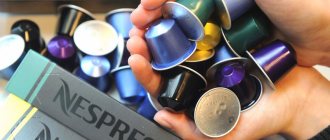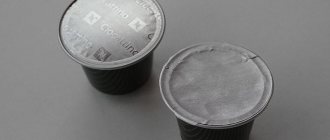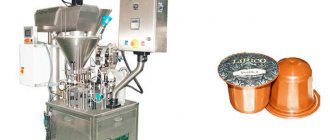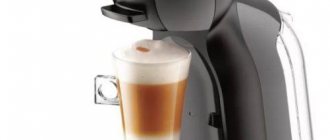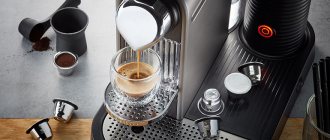Capsule coffee machines are becoming increasingly popular, as they differ from conventional ones in their ease of use: just insert the capsule and the drink is prepared. Coffee capsules are purchased separately and are sold in coffee shops and large supermarkets. The price for a package of branded capsules is relatively low, but questions often arise about how long a capsule lasts for a coffee machine, and is it profitable?
What is coffee capsules
A coffee capsule is a small sealed package made of aluminum, food grade plastic or a mixture of both materials. There is ground coffee inside. Coffee machine manufacturers usually produce capsules that are suitable only for their brand of appliances. However, there are also products on the market that are suitable for coffee makers from different brands. They are usually more expensive.
Most brands produce an expanded range of capsules for coffee machines. Thus, Nespresso produces over 20 different products.
This variety helps you choose the best capsules. They differ from each other in such indicators as:
- cooking methods;
- fortress;
- appearance;
- richness of taste;
- aroma.
So who are Nespresso?
Seriously? Okay, we'll explain everything to you.
Nespresso machines and coffee are produced by the Swiss company Nespresso, part of the Nestlé group of food companies. If you switch channels during commercials or head to the kitchen to make coffee, then you should watch Nespresso's most famous commercial. It stars the man who is the “face of Nespresso” – George Clooney.
Nespresso machines use an original, patented capsule system that produces a single mug of premium quality coffee. These machines are tamper-proof. You just need to load the selected capsule into the machine, press the “start” button and wait while the machine prepares and pours coffee.
When the machine runs hot water through the pod, the flavor of the coffee is extracted and the drink goes straight into your mug.
Before you start brewing, you can choose the size of the mug and the capsule you want to taste, as well as how strong you want the drink.
By the way, the Nespresso machine can be used to make lattes and cappuccinos. To do this, you will have to purchase an electric milk frother to finish the drink yourself.
What's inside
Inside the package there are usually mixtures of different types of ground coffee, diluted in certain proportions. This allows you to make the taste and aroma more pleasant and rich. Its weight varies from 5 to 9 grams.
The composition of coffee capsules is difficult to determine, since the manufacturer does not indicate information about it on the packaging. However, they often contain natural flavorings such as cocoa, cinnamon, and vanilla.
The product contained in the capsules is completely natural. The increased speed of its preparation is due to the high pressure in the coffee maker (about 15 bar) and the high level of perforation.
Types of capsules for coffee machines
There is a wide range of coffee capsules on the market. There are options for making espresso, latte, cappuccino, Americano and other types of drink. There are capsules that are used to prepare tea, hot chocolate or cocoa. The main difference is the material on which they are made. The most common varieties:
- Aluminum. Made from thin foil, they are in high demand due to their low cost. This material is inferior to others in terms of safety. Sometimes pieces of packaging along with the drink penetrate the body. Aluminum in small amounts is safe and will be eliminated from the body naturally, but many coffee drinkers prefer to use other options.
- Polymer. Made from food grade polymer. This is the most harmless material for the body, but its price is relatively high.
- Combined. Made on the basis of aluminum foil, polymer and compressed cellulose. The walls are made of simple polymers, and these products also contain aluminum, but it cannot enter the body in any way.
In addition to the usual disposable ones, there are a number of reusable capsules. Most often, they are made in the form of empty containers that you can fill yourself with any ground coffee beans. These packages are usually produced by third-party manufacturers who are not associated with well-known coffee brands. However, they also produce reusable packaging. They must be cleaned and filled with ground product, sealing with distemper if necessary.
Polymeric
Aluminum
The best capsule manufacturers
The top five market leaders include global producers of the best varieties of coffee, each of which has its own characteristics.
Nespresso
A well-known Swiss brand of coffee makers and coffee machines from the Nestle corporation, which also produces popular brands of Nesquik instant coffee and cocoa for children. The production of ready-made capsules began more than thirty years ago, and today the company offers 16 different combinations. Caffeine concentration is rated on a ten-point scale. The best samples are distinguished by a balanced grind size, since large granules have a weak aroma, and too small ones have an increased density that is difficult to brew.
The basis of the offer is classic Arabica, some blends are supplemented with the Rabusta variety:
- 7 varieties of “espresso” for a small cup of 40 ml, one of which is Italian ristretto, rated at a solid 10 points in terms of strength;
- “lungo” 110 ml, milder taste with reduced concentration;
- “espresso” of three pureorgin varieties, composed of Arabica beans collected in Colombia, South India and Brazil.
Containers made of branded food-grade plastic and a foil lid, which does not need to be opened before placing in the machine, are packed in 10 pieces and cost 320 rubles.
DolceGusto
A budget version from a subsidiary of Nescafe, offering more affordable coffee capsules. The main difference is the reduction in powder weight to 6 grams, which makes the drink less rich. The container is made of similar food-grade plastic.
There are more than 20 varieties of grain mixtures on the Russian market, including rare varieties with Arabica from Brazil, as well as the largest 300 ml portion in the “Preludio” series.
The kits include 16 capsules at a price of 380/420 rubles. DolceGusto capsules fit Krups or Delonghi models and offer flavors:
- 10 options of natural “espresso”;
- "espresso" without caffeine;
- regular coffee with milk;
- cappuccino;
- six types of latte, with two capsules;
- hot chocolate with different syrups (mocha, caramel, chocolate).
Tassimo
The French development with recognizable packaging in the form of rectangular bags with a flat tablet was made for various coffee machines, but after 2015 the brand was bought by the Bosch corporation, and the main flow of capsules began to be produced for German models.
A special feature of the product is the presence of a readable code on the packaging, according to which the coffee maker automatically switches on the preparation time and water dosage.
The density of the coffee powder is much lower than that of competitors, and the capsule weighs 9 g.
The line contains:
- three types of black coffee;
- cocoa;
- coffee with milk, including latte macchiato in a large mug (300 ml);
- hot chocolate;
- accompanying drinks (tea or hot milk).
The cost does not exceed the offer from Nestlé’s main competitor - 16 tablets are sold for 360 rubles.
Squesito
A young Italian company, which was created in 2005, and has been present on the Russian market for more than 10 years. She relied on mixing blends from Brazil, Kenya, Ethiopia, and Asia without adding flavorings or milk powder. The capsules are made of aluminum and bio-soluble plastic, so they can be called environmentally friendly.
The six-gram capsules contain an all-Robusta variant that delivers the highest concentration of caffeine with a bitter aftertaste. The price per unit reaches 35 rubles. Basic set includes:
- black coffee in four blends;
- decaffeinated coffee;
- hot chocolate.
An additional advantage is that it is compatible not only with branded coffee makers, but also with models from Philips.
Lavazza
The oldest Italian brand with more than a century of history (in 2016 it bought out the French CarteNoir and a number of European companies) brought the traditions of Italian coffee with dense, high brown foam to the Russian market. Food grade plastic capsules contain 7.5 g of coffee. The company offers six espresso options and different black coffee blends. The beans are supplied from Colombia, Brazil, Uganda, Costa Rica and other areas where the coffee tree grows.
The average cost of one serving is about 28 rubles.
Advantages and disadvantages
Coffee capsules have pros and cons. Their main advantages are:
- Preservation of taste and aroma after opening the package, unlike a ground or grain product.
- There is no need for careful pressing and measuring of the product, as is the case with carob coffee machines.
- Cost-effective, easy to use, compact and convenient devices.
- Possibility of preparing loose leaf tea (in many devices) . You just need to thoroughly rinse the device every time so that odors from different drinks do not mix in it.
- Availability of different tastes , the possibility of obtaining new products.
- Quick cooking. You just need to place the product inside the special compartment, place the cup on the tray, select the required recipe and press the start button.
- There is no need to use filters or constantly wash the device . The used pack is removed from the compartment and disposed of. Caring for the device consists of performing a number of simple procedures: pouring water, automatic rinsing, emptying the capsule container, and occasional washing using special products.
- The durability of the coffee machine, which allows you to use it for 10 years if you follow the instructions for use.
- Low noise level during preparation of a drink compared to standard coffee makers.
Coffee capsules also have some negative sides:
- High cost compared to regular coffee.
- Incompatibility with coffee makers produced by different manufacturers.
- Lack of product in mass sale, the need to pre-order it.
The mathematics of coffee capsules using the example of Nespresso capsules
To date, the iXBT laboratory has tested many coffee makers, including capsule models that work with Nespresso capsules. And if with all the other coffee makers we generally had an idea of what parameters we need to pay attention to and how the final result depends on them, then with regard to capsule coffee makers, until recently we still had questions one way or another.
What is the difference between them and is there any in principle? Does a capsule coffee maker make good coffee? Is it better or worse than other cooking methods? What are the pros and cons of capsule coffee makers? Which of them are real, and which are nothing more than marketing tricks? And finally, as they say: “what about the money?” How much will the overpayment for capsule coffee be and what can you try to do about it?
Let's figure it out.
History of Nespresso
Legend has it that back in 1975, a young Swiss engineer, Nestle employee Eric Favre and his wife were either simply walking the streets of Rome, or deliberately visiting various cafes in order to find a place where they prepared the best espresso.
Eric Favre
Eric Favre's attention was drawn to the espresso served at Sant'Eustachio il Caffè.
The same cafe Sant'Eustachio il Caffè
The barista reported that while preparing coffee, he did not immediately pass water through the ground beans, but did it “in pulse mode” - in small jerks, with short breaks, thus providing increased air flow to the ground coffee.
It was then that the idea was born to create a hemispherical capsule, into the base of which the inventor initially built a filter and membrane.
The piercing method was borrowed from the medical field - it was decided to pierce the capsules with a special needle in the same way as the rubber caps of medicine bottles are pierced with a syringe needle. Through the same needle, the coffee maker supplied first hot steam and then water into the capsule.
Prototype of the first capsule coffee maker
Here's how Eric Favre himself explained his logic: “The air consists of 20% oxygen. Oxygen oxidizes essential oils and allows them to be released faster. Espresso consists of a mixture of air, water and coffee oils. It's very simple, but no one has thought about it before." The inventor himself emphasizes that he came up with “not a capsule, but a technology, which is much more significant.”
Capsule coffee makers have undergone several stages of development: in 1986, the first copies were positioned exclusively as a premium product. “The idea was to keep the brand at the level of people who have a doorman,” said Nespresso CEO Jean-Paul Gaillard.
By the way, we are reminded of this by the sales system of Nespresso capsules, which still has the characteristics of an “elite club”: they are sold only in company stores, on the company’s official website and by phone.
The result, however, turned out to be worse than expected, so in 1988 Nespresso capsules appeared in a new guise - on the high-end consumer market.
More affordable capsules appeared in Swiss households, and two years later sales began in France and the United States. At this stage, the process did not proceed as quickly as desired, as a result of which Favre had to leave Nestle in 1991, after which he founded several successful coffee capsule companies, including Monodor, which still exists today.
Ironically, after 1991, Nestle’s business began to improve: already in 1993, due to growing demand for capsules, a second production line was opened at the factory in Orb, Switzerland.
In 1995, Nespresso broke even, becoming one of the fastest growing divisions of Nestle.
Nespresso De'Longhi Expert & Milk EN 355 GAE
Let's not bore the reader with stories about the numerous lawsuits that Nestlé's lawyers faced. Despite the presence of more than 1,700 patents, there were too many people willing to make money on the popular new product. One of Nespresso’s competitors subsequently became even the aforementioned Jean-Paul Gaillard, who founded his own company, the Ethical Coffee Company, and began offering coffee lovers cheaper and “ecological” biodegradable capsules compatible with original Nespresso coffee makers.
Nestle defended itself as best it could: it went to court, equipped its coffee makers with special mechanisms that blocked “foreign” capsules, but by 2012 most of the patents had expired, and almost anyone could start producing their own Nespresso-compatible capsules without fear of prosecution.
Nespresso continues to position itself in the “premium segment”. Budget capsules were separated into a separate brand - Dolce Gusto. In addition, Nespresso relatively recently launched new capsules and a new line of coffee makers - Vertuo. This system is designed for lovers of large portions of coffee, while classic Nespresso capsules are positioned as an ideal choice for lovers of espresso and drinks based on it.
In terms of statistics, the global coffee capsule market showed significant growth (averaging 18% per annum) between 2011 and 2016, before slowing down and appearing to have reached a saturation point for some time.
Design of a capsule coffee maker, advantages and disadvantages of the device
The key advantages of capsule coffee makers are low price and compactness.
If you look inside a capsule coffee maker, you will see that it is much simpler than even the simplest budget carob coffee maker, not to mention a full-fledged coffee machine with a built-in coffee grinder.
So, what is inside a capsule coffee maker? Not much: a pump for supplying water under pressure, a flow-through boiler that heats water in real time to the required temperature, and a brewing module (including a mechanism for “pushing” capsules and a system for discharging spent ones into a special container).
As we can see, there are practically no modules that require maintenance. The only element that could theoretically become contaminated is the place where the capsule is pressed “at the exit”.
Are there alternatives to capsule coffee makers if compactness is at the forefront? In principle, there are: for example, narrow compact carob coffee makers such as De'Longhi 685, the dimensions of which are 15x30x33 cm.
De'Longhi 685
But the Nespresso Essenza Mini has even smaller dimensions - 8.4 x 20.4 x 33 cm, so if we are talking about the fight for every 10 centimeters, the capsule coffee maker will still win.
Nespresso Essenza Mini C30
However, if we can afford to allocate an extra 15-20 centimeters on the kitchen countertop, then we have a choice.
De'Longhi 685
This leads to two indisputable advantages of capsule coffee makers: it is a simple device (without a built-in coffee grinder and a complex drainage system), which is extremely cheap to produce and in most cases will be more compact than other devices for making coffee.
The advantage of a capsule coffee maker is cleanliness?
Unlike automatic coffee machines and carob coffee makers, the user is not required to dispose of used coffee from the container, there is no need to clean and rinse the carob, and the drainage system does not dump water containing coffee oils into the tray.
Theoretically, the user may not even have to decalcify the device: due to the low price, you can use a capsule coffee maker until it breaks, and then just buy a new one.
Is a capsule coffee maker as easy to clean as it seems at first glance? Let's remember that it is the user's responsibility to clean the capsule containers (which contain residual moisture) and to promptly empty and clean (wash) the drip container.
Yes, of course, there won’t be as many drops here (as, for example, with a carob coffee maker, especially at a budget level - not equipped with a solenoid valve), and the container will have to be washed a little less often. And throwing the capsule into a bucket and rinsing the compartment is easier than fiddling with used coffee grounds. But! We cannot say that a capsule coffee maker requires no maintenance at all and does not produce waste. Here, too, moisture drips and accumulates, which means (in the absence of proper care) mold and dirt appear.
Quick change of coffee type
The undoubted advantage of a capsule coffee maker is the ability to instantly and without problems change the type of coffee. Automatic coffee machines will not allow you to take and drink, for example, a different type of coffee at any arbitrary moment (as an option - decaffeinated coffee). What if there are two people in the house with different coffee tastes who prefer different varieties?
But even if there is only one coffee consumer in the house, then, as a rule, he is limited to one or two types of coffee at a time: an increase in the number of open packs, even with grain coffee, inevitably raises questions regarding the storage of beans (the longer an open pack sits, the worse taste). What can we say about ground coffee, which spoils even faster?
Here capsule coffee makers win: after all, a capsule is essentially a mini-canned food that is opened immediately at the time of preparation. Therefore, theoretically (theoretically!) we can count on minor losses in the taste of the drink.
Let us remind you that we would recommend drinking open ground coffee within a week or two (provided it is stored in an airtight container), and beans within a month, and the loss of taste begins already in the third week.
What did they put in there for us anyway?
As soon as we start wondering what kind of coffee is in our capsule, we start to have problems.
The fact is that even large and well-known producers of bean coffee have become accustomed to not indicating the composition on the pack. We read the label and see something like: “this is some kind of coffee bean, a mixture of Arabica and Robusta in an unknown proportion.”
With capsules (especially capsules from “alternative” brands), this silence is made absolute. And Nespresso also doesn’t talk much about what’s inside the capsules. It says exactly that: “Ingredients: natural roasted ground coffee, natural flavoring.” Understand it as you wish.
Thus, no one is immune from the fact that in a coffee capsule we come across cheap varieties of coffee (often 100% Robusta, cheap Arabica varieties or a mixture of them in arbitrary proportions). No one is safe from the addition of chemical flavorings, no one is safe from the fact that a defect will be sent to the capsule - coffee that was stored incorrectly or was roasted incorrectly.
Moreover, the volume of coffee in a coffee capsule is, as a rule, 5 g. This is significantly less than the weight of a standard portion of coffee in a carob or automatic coffee maker (we will talk about this below).
Thus, the capsule manufacturer is faced with the task of obtaining the “taste of coffee” from a smaller volume of raw materials. This can be achieved in two ways - either by darker roasting (which spoils the taste of good grain), or by adding robusta beans - simpler and rougher in taste, with a pronounced bitterness.
It is clear that after this there can be no talk of any “refined taste”.
Dosage and method of preparation
During testing, we measured the time that the capsule coffee maker spends on preparing one serving. A capsule coffee maker takes approximately 18 seconds to prepare an espresso (40 ml), and approximately 26 seconds to prepare a lungo (110 ml).
Is this at all similar to classic espresso from a carob coffee maker? No, it doesn't look like it. For a single shot of espresso we take about 7 g of coffee, for a double - about 16 g, after which in 25-30 seconds we expect to get a drink that will weigh twice as much as the weight of ground coffee. How much water should a capsule coffee maker pour in order to maintain this simple 1:2 ratio? For 5 g of coffee in a capsule, the yield of the drink should be 10 g.
In practice, under the name “espresso” we get 35-37 g of drink in 18 seconds (ratio 1:7), what can we say about the so-called “lungo”, where by all rules it is desirable to maintain a ratio of 1:3?
40 ml espresso made from 5 g coffee
What about automatic coffee makers? Their average consumption is about 8-10 g per cup. You can put less, but what's the point?
And if we remember that many lovers of real cones have completely abandoned single espresso and now only add 16-18 g of coffee and brew only double espresso, since it is precisely this portion (according to modern fashion) that allows you to get the best taste?
The conclusions are disappointing: despite the fact that the creator of capsule coffee makers was initially looking for a new way to prepare the perfect espresso, in practice we get a coffee drink prepared to completely different standards. Moreover, these standards raise serious questions. For example, 18 seconds (without pre-wetting, which some machines have) is clearly not enough for proper extraction.
Owners of carob coffee makers can try pouring 40 ml of water through 5 g of coffee in 18 seconds and check for themselves what they end up with (spoiler alert - it won’t be even close to the espresso you’re used to).
However, for many, the strength of coffee from capsule coffee makers is “normal”. We even heard reviews that the coffee was “too strong.” Well, if people think so, let’s not argue with them and their taste.
This means there is a demand for such coffee.
Price per cup and overpayment per year
The fun begins when talking about price. Sellers of coffee capsules, as a rule, use the concept of “price per cup.” We think the reader has already guessed why: in this case, a cup is made from 5, and not from 7-10, or even 16-18 g of coffee.
Let's take a look at the current prices. Nespresso branded capsules are sold at prices ranging from 31 to 99 rubles, with most of them ranging from 37 to 41 rubles per piece.
Third-party manufacturers offer capsules at prices starting from 14 rubles (lower limit), Lavazza sells its capsules for about 30 rubles apiece, Starbucks - from 24 rubles, Auchan offers its “Red Bird” capsules for 24 rubles. It is clear that the prices quoted may vary and change significantly (for example, with discounts), but in general the picture emerges clear. Let's say that a spherical coffee drinker in a vacuum somehow got a capsule coffee maker for free and drinks one cup of coffee a day.
For the consumer of the cheapest Nespresso capsules, this amounts to 365×31=11,315 rubles. It’s easy to calculate that the coffee consumption in this case will be 365×5=1825 g, which gives us an impressive price for coffee: 6200 rubles per kilogram.
If the same spherical coffee drinker in a vacuum drank 1 cup from an automatic coffee maker, spending 10 g at a time (exactly twice as much), then in a year he would spend 3.65 kg of coffee. With the price of not the worst coffee being about 350 rubles per 250 g (Egoiste Espresso, Bushido, etc.), an annual supply of coffee will cost our lover 5,110 rubles.
The overpayment for the year, therefore, is 6,200 rubles (if you count in cups) or 8,760 rubles - if our coffee lover somehow learns to brew it 5 g at a time without the help of a capsule coffee maker and spends the same 1825 g of coffee in year.
It doesn't seem like much, right? You can live.
Although already here the amount of 8760 rubles is very close to the current price for a not very bad carob coffee maker like De'Longhi ECP 33.21 - 9390 rubles at the time of preparation of this material.
De'Longhi ECP 33.21
However, remember that we are considering a spherical coffee drinker in a vacuum. A real person, as a rule, drinks not one, but a couple of cups of coffee a day - and now the overpayment increases from 8,760 to 17,520 rubles per year.
A real person, as a rule, does not live alone. The second same coffee lover in the house will automatically double the annual overpayment, after which it will exceed 35,000 rubles.
Let's also not forget about relatives and friends who come to visit. We think it’s clear where this is going?
But for already 31,000 you can get an automatic coffee machine like the De'Longhi Magnifica ESAM 4200 - with a built-in coffee grinder (and switching to grain will further increase the gap between the price of a cup, and therefore the overpayment for the year).
Comparison table with prices at the time of preparation of the material (according to Ozon.ru)
| Brand | Type | Packaging price, rub. | Coffee weight, g | Coffee price, per gram | Costs per 1 cup (based on the price of 1 capsule or 7 g for bean and ground coffee) | Costs per 100 cups, rub. | Costs per year (1 cup per day), rub. |
| Nespresso | capsule (minimum price) | 31 | 5-5,5 | 5,636 | 31 | 3100 | 11 315 |
| Nespresso | capsule (average price) | 41 | 5-5,5 | 7,454 | 41 | 4100 | 14 965 |
| Live Coffee Ethiopia Sidamo (10 capsules) | capsule (lower price segment) | 132 | 50 | 2,64 | 13,2 | 1320 | 4818 |
| Coffesso Classico Italiano (10 capsules) | capsule (mid price segment) | 279 | 50 | 5,58 | 27,9 | 2790 | 10 183 |
| Nespresso, Master Origins Aged Sumatra | most expensive Nespresso capsule | 99 | 5,5 | 18 | 99 | 9900 | 36 135 |
| Paulig arabica | ground, 250 g | 237 | 250 | 0,948 | 6,636 | 663,6 | 2422 |
| Paulig arabica | grain, 1 kg | 641 | 1000 | 0,641 | 4,487 | 448,7 | 1637 |
| Lavazza Oro | ground, 250 g | 262 | 250 | 1,048 | 7,336 | 733,6 | 2677 |
| Lavazza Oro | grain, 1 kg | 936 | 1000 | 0,936 | 6,552 | 655,2 | 2391 |
| Guatemala Maragogype | ground, 250 g | 700 | 250 | 2,8 | 19,6 | 1960 | 7154 |
| Guatemala Maragogype | grain, 1 kg | 2 568 | 1000 | 2,568 | 17,976 | 1797,6 | 6561 |
What to do?
Faced with such numbers and discovering how quickly capsules are consumed even in a small family, our coffee lover often begins to try to save money: refuses the second cup of coffee a day, does not offer coffee to guests, or begins to look at cheaper offers.
As a result, the situation is paradoxical: the device, which was initially positioned as a top-level coffee maker, leads to the fact that its owners either cannot afford to drink coffee in the quantity they want, or switch to cheaper capsules, and as a result, openly drink bad or completely unusable coffee.
And at the same time they continue to spend so much money on their hobby, which could well be enough to drink the best coffee in the specialty category (this class is awarded only to Arabica, or rather, less than 10% of its entire production).
At the same time, the market situation tells us that the already dubious quality of capsule coffee is unlikely to increase: the pressure of third-party capsule manufacturers on Nespresso and on each other is quite high, and the growth of the coffee capsule market has slowed down. Not everyone will be able to survive in a competitive environment, and even then by reducing, rather than increasing, the quality of the product. Why not lower it if they still buy the capsules?
The question remains open: how do capsule manufacturers still manage to position their products as premium?
Let's give an analogy: everyone understands that tea bags are not at all the product that will appeal to a true tea lover. It is obvious to everyone that in the vast majority of cases, “tea from a bag” = “bad tea.” Why do coffee capsules still have a reputation as a premium product? We don't have an answer to this question.
This situation indirectly affects the equipment that is supplied to store shelves: developers often stop developing full-fledged coffee makers, concentrating their efforts on the production and sale of capsule models (we remember that in general they turn out to be both simpler and cheaper?)
Who chooses capsules?
It would probably not be wrong to say that the capsule coffee maker industry is an example of the quintessence of consumer attitudes towards a product.
The user of the capsule coffee maker completely voluntarily refused even the slightest attempts to independently influence the taste of the drink, with the possible exception of its volume.
However, this “flaw” has already been corrected: the new Nespresso Vertuo system has gone even further, not allowing the user to even select the volume of the drink (the coffee maker automatically reads the barcode on the capsule and determines how much water to pour). You don’t need to think at all, the capsule manufacturer has made all the choices for you.
Nespresso Vertuo system capsule
Thus, we come to an unexpected conclusion: the average user of a capsule coffee maker in the vast majority of cases has nothing in common with a coffee lover and connoisseur.
Consumers of cheap capsules are essentially ready to drink a drink that has little in common with coffee as such. Those who don’t save consume coffee of average quality at best (!). The resulting drink is comparable to the result demonstrated by cheap (but not the worst) carob coffee makers such as the De'Longhi ECP 33.21 already mentioned above. Moreover, let us remember that home carob coffee makers have “improvers” that correct grinding, filling and tamping errors, so you can brew decent coffee even from purchased ground coffee, without a home coffee grinder.
Conclusions: when and where is a capsule coffee maker appropriate?
Is it really that bad? Perhaps there are situations when capsule coffee makers would be in their place? Yes, of course, such situations exist.
A capsule coffee maker will find its place where cleanliness and ease of preparation are at the forefront, or (oddly enough) - where coffee is almost never drunk (that is, the consumption will be so small that even a 200-gram pack will have time to will spoil before it is drunk).
Capsule coffee makers will come in very handy on trains, long-distance buses, and trailers (ideal for those who are not ready to travel without a coffee maker). Capsules are an excellent solution for situations where control of coffee consumption is required - for example, in the real estate rental business (apartments with daily accommodation, hotels, etc.)
We are trying to save money
What should we do if we somehow got a capsule coffee maker? Is it possible to find an adequate use for it without overpaying exorbitant prices for coffee?
To understand this issue, we purchased reusable capsules on Aliexpress and began experimenting.
How does a reusable capsule work? There are several most common options.
Ours (the most budget-friendly) involves the use of plastic capsules with plastic hinged lids and a nylon filter.
The price is about 250 rubles for a set of 6 pieces, the set includes a cleaning brush and a plastic tamper spoon. The main disadvantage of such capsules is the fragility of the plastic.
A more expensive option is metal capsules and disposable self-adhesive foil stickers.
Three capsules with tempera will cost 870 rubles, a set of six capsules and tempera will cost a little more than a thousand. The stickers are quite expensive - 980 rubles for 360 pieces, which is 2.72 rubles per piece.
You can take more and cheaper, but without confidence that the whole system will work as it should, you don’t want to.
Finally, there are metal reusable capsules with a metal lid.
Cost - from 670 rubles per piece (without additional accessories). Or from 1500 to 2000 rubles for a set of three pieces (with metal tempera).
The main, in our opinion, disadvantage of all these solutions is that reusable capsules are slightly smaller in size than standard ones. Where a standard capsule should be “pressed”, a reusable one should feel free - otherwise there is a risk of damaging the mechanism of the coffee maker.
Thus, on average, 0.5-1 g less coffee is placed in one reusable capsule, and we already know that there is not much coffee in a standard capsule - usually 5 g.
We armed ourselves with a coffee grinder, coffee beans, ground coffee from the store, original Nespresso capsules, as well as capsules from third-party manufacturers, and decided to see what kind of coffee we could brew from this set.
What kind of coffee can be found in capsules?
Let's take a look at the coffee we found inside the capsules.
The first comparison is a Nespresso Ciocattino capsule versus freshly ground coffee (Lavazza Rossa) from a home grinder set to brew espresso in a cone.
The naked eye can see how different the grinding is (in Nespresso it is slightly smaller) and roasting - we see that in Nespresso the color of the coffee is much darker.
And this despite the fact that Lavazza Rossa is in itself a rather “evil” coffee for those who love its characteristic bitterness.
Our assumptions are confirmed: capsule manufacturers use stronger roasting in an attempt to “squeeze” the strongest and most consistent flavor out of a small volume of coffee.
Here is a comparison of several “alternative” capsules.
This is what they look like when sealed (from left to right - Nespresso, Live Coffee, Coffesso, reusable plastic capsule).
Let's open the alternative capsules and see what's inside.
On the right is the same Lavazza Rossa grind again. As we can see, here the left capsule (“Live Coffee”) is not very different in color, and the central one (Coffesso) also differs in the darker direction (although not as much as Nespresso).
Measurements using scales showed that the values stated on the box were observed.
In one capsule you can most often find 5 g of coffee, less often - up to 5.5 g.
Next, we compared the drinks by appearance.
On the left is Nespresso Arpeggio (dark roast), on the right is “Live Coffee”.
On the left is Nespresso Arpeggio (dark roast), on the right is Coffesso.
We taste it, taking Nespresso as the “quality standard” - watery, but similar to espresso.
"Live Coffee" completely disappointed us. It turned out to be even more watery, not at all like espresso. "Coffesso" proved to be something in between. In our opinion, the coffee also came out watery, but with a distinct bitterness, making the taste more pronounced.
Now we are trying to make coffee in a reusable capsule. Capsule weight - 4 g.
First, we try to fill it with 5 g of coffee (the grind is standard for a homemade cone).
...and we are defeated: the coffee maker was unable to properly dispense the required amount of water.
Attempt number two - what if we try to fill it with the same coffee that we just took out of a regular Nespresso capsule?
The result is a little better, although the total volume of the drink turned out to be two times less. This, however, had a positive effect on the taste: the drink turned out to be much stronger. Please note that the characteristic foam has disappeared even though we are using coffee that has just been removed from the “official” capsule.
Third attempt - take regular inexpensive ground coffee from the store and fill it into a capsule “as much as you can”, without strong tamping (i.e. 4-4.5 g).
Hit!
On the left is Nespresso Arpeggio (without cream foam), on the right is our budget coffee from a reusable capsule. As you can see, the volume of the drink turned out to be slightly smaller, but not significantly - by 5-8 g at most (in the cup on the left, let us remember, there are 37-38 g of coffee).
The taste of the drink, in our opinion, turned out to be comparable to capsules from the middle price category - no worse than “Coffesso”, and without a doubt better than what “Live Coffee” offers us. The only difference is that the foam of the cream was not so pronounced - in the cup we did not see anything even close to the characteristic Nespresso “head”.
Of course, we repeat, we are not talking about any “espresso taste” here and cannot be. Even with the “official” Nespresso capsules, which continue (in our opinion - erroneously) to be positioned as capsules for making espresso-based drinks. Whereas it would be more honest to promote them as a solution for lovers of lungo and other “big cups of coffee” (as is done in the Vertuo system).
As for the reusable capsules themselves, our conclusion, therefore, is that they deserve the right to life - at a minimum, you can make coffee in them, and we got the best result (oddly enough) using ordinary ground coffee from store This means that it is not at all necessary to have a special coffee grinder for these tasks: it is quite possible to choose a suitable ready-made grind from those varieties that are on the market.
Conclusions: is it possible to save money on reusable capsules?
The use of reusable coffee capsules has a right to exist, but with several caveats.
Firstly, the volume of such capsules is slightly smaller than standard ones, which means that the strength of the finished drink will be slightly lower than usual. If you are used to pressing the “Lungo” button and pouring 110 ml through a standard capsule, then an adequate solution would be to launch the “espresso” program twice with 40 ml each.
If you want to get closer to the original espresso, and capsule coffee already seems too watery to you, it’s better not to even try.
Secondly, you need to understand that plastic capsules are short-lived (alas, we cannot accurately predict their service life, but it is clearly not infinite), and reusable metal capsules with metal lids will cost a lot of money (especially if we need a whole set that allows fill capsules for several days in advance in one go).
Capsules with stickers can be a kind of compromise: despite the fact that we are trying to save money, we pay 2.72 rubles per sticker, which is about 25%-30% of the price of a cup of coffee.
Thirdly, when we try to switch to reusable coffee capsules, we go against the main idea of capsule coffee makers, which is to provide us with the opportunity to get coffee without fussing with beans, grinding and all the related things.
Here we will either have to grind the coffee ourselves, or select the appropriate ground coffee and buy it exclusively (for fear that another variety will require adjustment of the grinding). And, of course, regularly engage not only in “filling” the capsules, but also in cleaning them. And this is already comparable to the cost of maintaining a regular carob coffee maker.
It turns out that the whole difference here is that you can fill the capsules once a week, but the cone needs to be cleaned after each preparation.
And here a completely reasonable question arises: is it worth starting this whole story at all?
In our opinion, if you don’t already have an existing capsule coffee maker at home that you want to put to use, then don’t.
If you are on a limited budget, it is better to buy an inexpensive drip or geyser coffee maker (or even a regular funnel with paper filters) and not fool yourself with all these nuances regarding setting the grind and the need to wash reusable capsules.
A geyser coffee maker is one of the simplest and most budget-friendly ways to get decent quality coffee at home.
If you have a little more free money and are interested in the topic of coffee, perhaps you should take a closer look at inexpensive carob models or straight away to an inexpensive machine.
Well, if your household somehow has a capsule coffee maker (especially if it’s an expensive model or a gift that you’d hate to get rid of), and you’re basically satisfied with the quality of the coffee it brews, then, of course, you can try reusable capsules. After all, 1000 rubles for the owner of a capsule coffee maker is the price of less than 30 capsules.
If the result is considered satisfactory, the purchase will pay for itself within a month.
Rating of the most popular types
Nespresso capsule coffee is considered the best . This manufacturer produces more than 20 varieties. The company produces both disposable and reusable packaging, which have a special design that allows them to be brewed several times.
The rating also included Tassimo products . It is produced in the USA and sold all over the world. The kit includes a description of the technology for preparing the drink, the volume of coffee received and other useful information.
The list of the best coffee capsules ends with Dolce Gusto , which is produced by Nestle corporations. The product range is wide and includes various flavors with the addition of sugar, milk and tea. Some packages can be used twice.
Tassimo
Nespresso
Nescafe
What are the benefits of reusable capsules?
Whatever you say, portion preparation of any coffee drink is very convenient. Using empty capsules for coffee machines, you can fill them in advance with the desired amount of coffee, sugar, milk and seal them with foil. The latter always comes complete with products from Dolce Gusto, Cremesso, Nespresso and Tassimo.
These capsules allow you to experiment with flavors and different recipes for coffee drinks. With them you can save significantly by using, for example, coffee powder purchased by weight, which is much cheaper. How long such capsule products last depends on the frequency of their use - on average, 30-35 cups.
Coffee capsules should usually be the same brand as the coffee machine. There are cases of their compatibility with different devices. This is usually indicated in the instructions for the device. You should not purchase capsules for a coffee maker in specialized stores, as there is a possibility of buying analogues counterfeited to resemble the original. In this case, your coffee device may be damaged.
Coffeduck
Popular plastic containers costing about RUB 150 each, suitable for Nespresso machines. When purchasing, it is enough to follow a simple rule: if the device was released before 2010, then a brown container will do. If the machine is newer, then the black container will fit perfectly on the tray.
Capsulin
The French manufacturer offers 100 plastic tanks for 500 rubles, including a dispenser and self-adhesive foil lids. The practicality of this solution lies in the possibility of using containers in all coffee machines up to 20 times.
MyCap
A more expensive type of capsules (10 pieces and 40 caps for 900 rubles) due to the special design of the sides, which gives good tension to the foil, and holes in the bottom. These features improve the quality and aroma of the drink even when prepared independently.
Emohome
High-quality reusable cups for Nespresso machines manufactured after 2010. The coffee mixture is protected from air and light by the silicone ring that comes included.
Tassimo
Capsules for repeated use of this brand are mainly produced by the Chinese market. They can be purchased through an order on Aliexpress. But the quality of plastic cups with a disposable lid will be very mediocre.
Benefits and harms of capsule coffee
Coffee capsules provide the same benefits as a regular grain drink. It helps you wake up faster, gives you a boost of energy, and improves your mood. Calorie content is 290 kcal per 100 grams of product (20-30 kcal per serving).
Sometimes you may come across the point of view that drinking such a drink is dangerous, but in fact, the harm of coffee capsules is greatly exaggerated. There are usually no additional substances inside the pack, other than ground grains and natural spices.
Capsule coffee is a healthy and easy-to-prepare product. Proper brewing will help you constantly enjoy the drink. You can prepare coffee capsules every day without thinking about the harm to your health.
